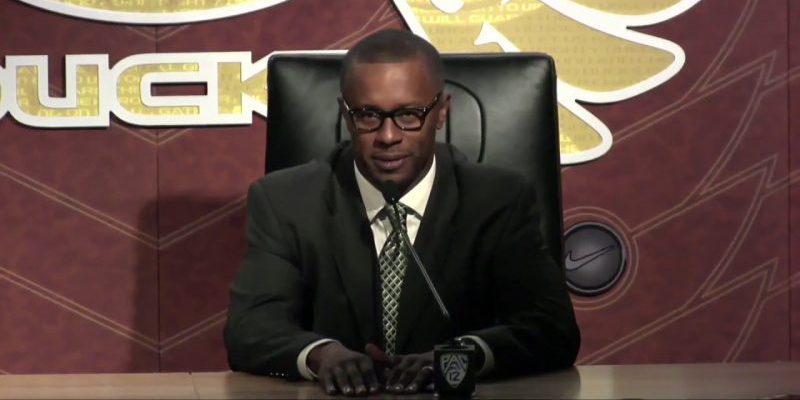In his first press conference as the Oregon Football head coach, Willie Taggart presented his organizing mantra: ”Make no excuses. Blame no one. Do something.” With few exceptions, Taggart has stuck to his commitment to make no excuses. But if Taggart won’t make excuses for the Ducks, somebody must because our expectations for this year should be tempered by the good excuses the Ducks have declined to assert. So, I’ll make some excuses for Willie Taggart.
Underlying Problems

Deommodore Lenoir
As I wrote a month ago, despite a fast start, the Ducks were bound to struggle once they hit the Pac-12 schedule. And that was before California snapped Justin Herbert‘s collarbone and concussed backup Taylor Alie. The Ducks are still young in the secondary (even younger now that Deommodore Lenoir is getting more playing time) and are still making freshman mistakes there. And despite bizarre statements by ESPN analysts to the contrary, the Pac-12 is still the deepest conference in the country (hence the upset of both Washington teams this weekend). Finally, Taggart is still a questionable play caller.
Worse still, my concern about Herbert’s ability to throw the deep ball looks nitpicky now that Alie and Braxton Burmeister appear more likely to throw to an opponent than an Oregon receiver every time they throw vertically. Bring back Herbert’s deep ball!
On the flip side, the offensive line is looking better than I thought. While the Ducks struggle, at times, to run between the tackles, I believe that is more due to uninspired play-calling than lack of size in the trenches. For the most part, the line’s run blocking has been one of the few bright spots on this offense.
Injuries
Oregon has suffered catastrophic injuries. Herbert’s injury reminds me of Dennis Dixon‘s fateful 2007 buckled knee. Then, as now, our high-flying offense has been hampered by an injury at the most important position, leaving the offense a shell of itself. Except this time, the Oregon offense already showed signs of fluttering and has now fallen lower than it did following Dixon’s injury.
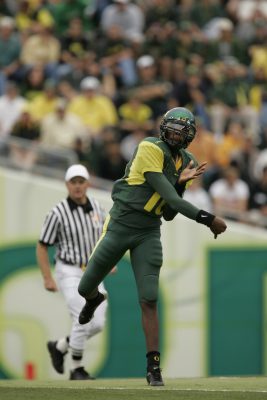
Dennis Dixon launching a pass downfield back in 2004
It goes without saying that Herbert’s injury was one the Ducks could not afford. Prior to his injury, the offense averaged over 50 points per game. And while the Ducks miraculously scored 28 points against California after Herbert was injured in that game, they have scrapped together a mere 17 total points in the two games since.
While Herbert’s is the most notable Duck injury this season, several others have also hurt the team. On offense, Royce Freeman was injured against California and still doesn’t look 100% (more on this later). Additional injuries to starting receivers Charles Nelson and Dillon Mitchell left the Ducks with even fewer weapons.
On defense, injuries to linebackers Kaulana Apelu and A.J. Hotchkins have left the Ducks playing third-stringers Blake Rugraff, Jimmie Swain, and previously-redshirting Sampson Niu. While the backup linebackers have mostly acquitted themselves admirably (playing opposite bona fide star Troy Dye helps), the injuries have started to show, as both Washington State and Stanford found success running the football.
Thin at Key Positions
The Ducks are undergoing a youth movement, which is great for the development of futures stars and recruiting. Every recruit wants to play early, and Taggart can make a credible case that they’ll be afforded that opportunity. But Oregon’s youth movement can also be viewed through a “glass-half-empty” lens. In other words, so many freshman are playing because the team lacks veteran talent. The secondary that struggled so much last season has been bolstered by an infusion of young talent. But even as good as these freshmen are, they shouldn’t have been able to come in and win starting spots so easily. (It’s reminiscent of the way Vernon Adams Jr. was able to wrest the starting spot away from Jeff Lockie despite missing part of fall camp, and we all saw why in the Alamo Bowl.)
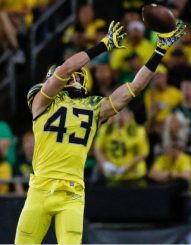
Brenden Schooler started at safety last year.
The aforementioned injuries to Nelson and Mitchell highlighted a thin position at wide receiver that has already needed reinforcements from two converted defenders (Brendan Schooler and Malik Lovette) as well as a former running back (Taj Griffin). Likewise, the inexperience at middle linebacker, as outlined above, has been exposed. Both Washington State and Stanford have exploited our linebackers for chunk plays in the last two games.
The good news is that help is on the way … next year. Taggart and co. have proven themselves able recruiters and have secured ample recruits at thin positions (though, if Taggart keeps running his quarterbacks, I’d like to see another commitment there as well).
New Defense
There’s not much to say here other than the defense is adjusting to their third defensive coordinator in as many years. And they’re making the transition back to a 3-4, from which they transitioned just last year. While veterans no doubt remember the 3-4 concepts, Jim Leavitt‘s terminology and technique is different. While this can seem like a small detail, there will always be growing pains when a team is transitioning between coordinators.
Royce Freeman Underperforming
Given what Royce Freeman has already accomplished as one of Oregon’s best running backs in the team’s history, it’s painful to say, but Freeman has begun to underperform this season. If you discount his longest runs from each game this season, Freeman has averaged under five yards per carry against every opponent except Southern Utah and California (against whom he only had eight carries). And he hasn’t scored a touchdown since his single touchdown against Arizona State.
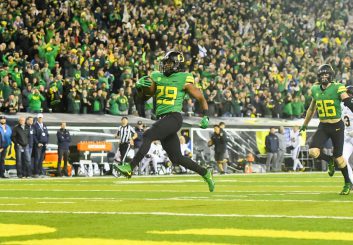
Kani Benoit has frequented the end zone this season.
Statistics aside, Freeman simply looks slow. Once he builds up a head of steam, his top-end speed is no joke, but he’s slow to the hole and suffers from indecision. To be honest, Kani Benoit looks like our best running back this season. Benoit has only two fewer touchdowns than Freeman on 82 fewer carries.
It’s unclear how much Freeman’s injury against California is a factor here. Given that it was a shoulder injury, it may limit him in the passing game, but it shouldn’t slow him down. That said, he has looked more tentative to make contact at the end of runs, which may be a product of injury.
What is also unclear is the extent to which Freeman’s performance is due to play calling (see below).
No Excuses for Poor Coaching Decisions
While the Ducks have many good excuses for their losses this season, several problems are self-inflicted.
1. Offensive play calling
As discussed on FishDuck.com many times, Taggart’s offense shows signs of unimaginative and predictable play calling. While the offense is now limited without Herbert, Taggart must adjust his play calling accordingly. The good news is that he’s previously shown a willingness to do just that (when, at South Florida, he shifted from a pro set to his own “Gulf Coast” design).
2. Running the quarterback
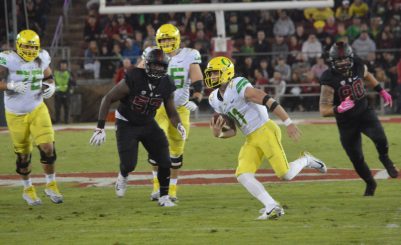
Braxton Burmeister risking it all.
Charles Fischer must be somewhere hitting his head against a wall. After losing two quarterbacks to injuries sustained on designed runs, Taggart had Burmeister run the ball nine times against Stanford. If Taggart hurts a third quarterback, he’ll have only himself to blame.
Expectations Going Forward
At this point in the 2017 season, Charles’s 6-6 prediction is looking optimistic. The good news is that the Ducks have some good excuses for their shaky performance thus far, which is important because recruits want to see that improvements are being made and that a dynasty is being built. While Taggart won’t make excuses, here’s to hoping recruits understand the potential of this team and why it is currently on a two-game skid.
Cody Lonning
Oakland, California
Top photo credit: Kevin Cline
Related Articles:
Oregon Enters Playoffs Better Off Than Last Year
Will The Coaching Carousel Kill Oregon's CFP Chances?
The Playoff Formula Hasn't Changed
Oregon Aims to Bury Dawgs, Punch Playoff Ticket in Rivalry Clash
Huskies Are the New Beavers, Stay In Your Lane Kiffin, and the Civil Apple Cup War
Oregon Football: The X-Factor Vs. Washington
Cody inherited all his sports allegiances from his grandfather, a long-time Eugene resident. Even though Cody graduated from law school at Berkeley, he remains a staunch Oregon fan. When he isn’t watching the Ducks, Cody is hiking, engaged in various home-improvement projects, or writing about politics. Cody grew up farming hay and wheat in Eastern Washington. Now, he practices law.

